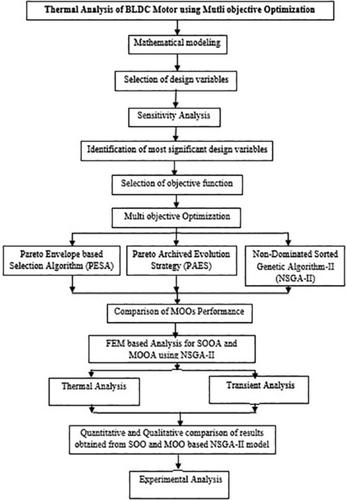当前位置:
X-MOL 学术
›
Int. Trans. Electr. Energy Syst.
›
论文详情
Our official English website, www.x-mol.net, welcomes your feedback! (Note: you will need to create a separate account there.)
Thermal analysis of brushless DC motor using multiobjective optimization
International Transactions on Electrical Energy Systems ( IF 2.3 ) Pub Date : 2020-08-10 , DOI: 10.1002/2050-7038.12546 Kamal Chakkarapani 1 , Thyagarajan Thangavelu 2 , Kalpana Dharmalingam 2
International Transactions on Electrical Energy Systems ( IF 2.3 ) Pub Date : 2020-08-10 , DOI: 10.1002/2050-7038.12546 Kamal Chakkarapani 1 , Thyagarajan Thangavelu 2 , Kalpana Dharmalingam 2
Affiliation

|
In this article, the design of brushless DC (BLDC) motor is performed using multiobjective optimization algorithm (MOOA) by satisfying multiple objectives. Initially, sensitivity analysis is carried out to find the most influencing parameters that affect the performance of BLDC motor. MOOAs such as Pareto envelope‐based selection algorithm (PESA), Pareto archived evolution strategy (PAES) and nondominated sorting genetic algorithm‐II (NSGA‐II) is employed in the optimal design of the BLDC motor. The proposed MOOA have three objectives namely: output torque maximization, volume minimization, and minimization of total losses. MOOAs are analyzed using performance metrics and qualitative comparison is provided to select the best algorithm. Later, finite element method (FEM) is used to investigate the transient and thermal characterization on the BLDC motor designed using NSGA‐II. The thermal results thus obtained using NSGA‐II for the above motor under different operating conditions is also compared with the existing single objective optimization algorithm. From the comparisons, it is observed that NSGA‐II algorithm significantly outperforms the existing single objective optimization algorithm. Finally, the usefulness of the designed machine based on NSGA‐II is compared with the results obtained from simulation and hardware analysis.
中文翻译:

基于多目标优化的无刷直流电动机热分析
在本文中,通过满足多个目标,使用多目标优化算法(MOOA)进行了无刷直流(BLDC)电机的设计。最初,进行灵敏度分析以找到影响BLDC电机性能的最有影响力的参数。在BLDC电机的优化设计中,采用了基于Pareto基于包络的选择算法(PESA),Pareto存档进化策略(PAES)和非控制排序遗传算法II(NSGA-II)等MOOA。提出的MOOA具有三个目标,即:输出扭矩最大化,体积最小化和总损耗最小化。使用性能指标分析MOOA,并提供定性比较以选择最佳算法。后来,有限元方法(FEM)用于研究使用NSGA-II设计的BLDC电机的瞬态和热特性。使用NSGA-II在上述电动机在不同工作条件下获得的热结果也与现有的单目标优化算法进行了比较。从比较中可以看出,NSGA-II算法明显优于现有的单目标优化算法。最后,将基于NSGA-II的设计机器的实用性与通过仿真和硬件分析获得的结果进行了比较。可以看出,NSGA-II算法大大优于现有的单目标优化算法。最后,将基于NSGA-II的设计机器的实用性与通过仿真和硬件分析获得的结果进行了比较。可以看出,NSGA-II算法大大优于现有的单目标优化算法。最后,将基于NSGA-II的设计机器的实用性与通过仿真和硬件分析获得的结果进行了比较。
更新日期:2020-10-11
中文翻译:

基于多目标优化的无刷直流电动机热分析
在本文中,通过满足多个目标,使用多目标优化算法(MOOA)进行了无刷直流(BLDC)电机的设计。最初,进行灵敏度分析以找到影响BLDC电机性能的最有影响力的参数。在BLDC电机的优化设计中,采用了基于Pareto基于包络的选择算法(PESA),Pareto存档进化策略(PAES)和非控制排序遗传算法II(NSGA-II)等MOOA。提出的MOOA具有三个目标,即:输出扭矩最大化,体积最小化和总损耗最小化。使用性能指标分析MOOA,并提供定性比较以选择最佳算法。后来,有限元方法(FEM)用于研究使用NSGA-II设计的BLDC电机的瞬态和热特性。使用NSGA-II在上述电动机在不同工作条件下获得的热结果也与现有的单目标优化算法进行了比较。从比较中可以看出,NSGA-II算法明显优于现有的单目标优化算法。最后,将基于NSGA-II的设计机器的实用性与通过仿真和硬件分析获得的结果进行了比较。可以看出,NSGA-II算法大大优于现有的单目标优化算法。最后,将基于NSGA-II的设计机器的实用性与通过仿真和硬件分析获得的结果进行了比较。可以看出,NSGA-II算法大大优于现有的单目标优化算法。最后,将基于NSGA-II的设计机器的实用性与通过仿真和硬件分析获得的结果进行了比较。


























 京公网安备 11010802027423号
京公网安备 11010802027423号